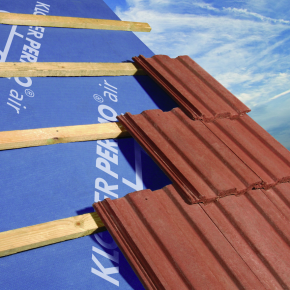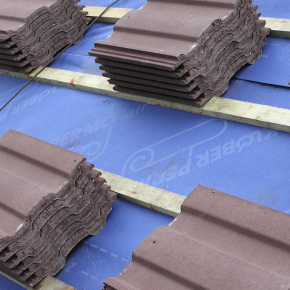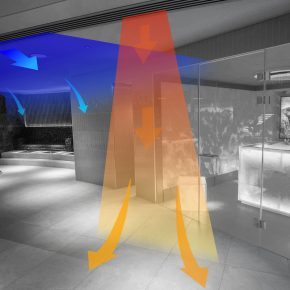
Klober responds to amendments of British Standards for slating and tiling
Klober responds to the recent amendments to the British Standard for slating and tiling as it now recognises that air permeable underlays can take the place of ventilation in a cold roof.
As of February this year, BS 5534, the code of practice for slating and tiling, provides minimum air permeability figures for underlays that allow them to be used without any other ventilation in a cold roof.
This is potentially good news for roofing contractors. Pick the right underlay, and there’s no need to spend the time and money on installing additional ventilation at the ridge.
Cold roof conundrums
 Historically, there have been problems with breathable underlays. The problem was really with our understanding and definition of a ‘breathable’ underlay as there is more to an underlay being breathable than air being able to get through.
Historically, there have been problems with breathable underlays. The problem was really with our understanding and definition of a ‘breathable’ underlay as there is more to an underlay being breathable than air being able to get through.
Until the February amendment to BS 5534, a non-breathable, or HR (high water vapour resistance) underlay was classed as one with vapour resistance greater than 0.25 MNs/g and a breathable; or LR (low resistance to water vapour) had a vapour resistance less than 0.25 MNs/g. No mention of air permeability.
This year’s amendment to BS 5534 sets down a specific value for air permeability: an LR underlay must have a water vapour resistance less than 0.25 MNs/g combined with an air permeability of not less than 20 m3/m2h at 50 Pa. So, for example, Klober’s Permo air would meet this new definition. It has a water vapour resistance of 0.045MNs/g. In respect of air resistance, tests at the Building Research Establishment delivered results of 63 m3/m2 hr at 50 pascals.
Fewer fixings
If the underlay is allowing air to pass through, then that also implies that the ridge and hip tiles will be taking more force from the wind lift than if the underlay was impermeable to air, although less force than if there was an open gap. This is expressed by the shielding factor ‘S’, and the February amendment sets down what S should be for the various situations.
Were a non-ventilating underlay to be used, S would be 0.1. For ventilated ridges (and roofs without underlay) S is 1.75 and for roofs with air permeable membranes S is 1.5. This means that with an air permeable membrane such as Permo air, fewer fixings are needed than if high-level ventilation had to be incorporated.
Another important consideration when choosing underlay for cold roofs is how airtight the ceiling below the roof is. The latest amendment to BS 5534 tackles this issue by getting rid of references to a ‘well-sealed ceiling’ and instead defining a ‘continuous ceiling’ as one with 30mm2/m2 or less and a ‘discontinuous ceiling’ as one with more than that figure.
Taking all things into consideration, the choice of a vapour and air permeable underlay is often the right choice for both roofing contractor and the housebuilder. As well as time and materials saved on the roof, this solution means that the house is watertight sooner, with the positive impacts to programme that this can bring.
Klober Ltd
Unit 6F,
East Midlands Distribution Centre
Short Lane
Castle Donington
Derbyshire
DE74 2HA
Tel: 01332 813050
Visit Supplier's page
Latest news

2nd April 2025
FIT Show 2025 Launches Innovative Marketplace Feature to Enhancing Value for Installers
FIT Show, the UK’s leading event for the window, door, flat glass, hardware, and roofing industries, is excited to announce the launch of a brand new Marketplace feature at its upcoming 2025 event (Birmingham NEC, 29 April – 1 May).
Posted in Architectural Ironmongery, Articles, Building Industry Events, Building Industry News, Building Products & Structures, Doors, Exhibitions and Conferences, Glass, Glazing, Hand Tools, Innovations & New Products, Plant, Equipment and Hire, Power Tools, Restoration & Refurbishment, Retrofit & Renovation, Roofs, Seminars, Training, Windows
2nd April 2025
Hi-spec deployment of EJOT Colorfast at new Birmingham logistics park
EJOT Colorfast fasteners have been used extensively in the construction of eight new high-specification warehousing and logistics buildings at the Urban 8 Logistics Park in King’s Norton, Birmingham.
Posted in Articles, Building Industry News, Building Products & Structures, Building Systems, Case Studies, Facades, Restoration & Refurbishment, Retrofit & Renovation, Roofs, Walls
2nd April 2025
SWA member delivers ‘fresh Hope’ for university’s Sustainable Building department
A detailed contract to restore an iconic Art Deco building in the heart of Birmingham’s Jewellery Quarter was carried out by Steel Window Association member, The Window Repair Company (Northwest) Limited.
Posted in Articles, Building Associations & Institutes, Building Industry News, Building Products & Structures, Building Systems, Case Studies, Glass, Glazing, Restoration & Refurbishment, Retrofit & Renovation, Steel and Structural Frames, Sustainability & Energy Efficiency, Windows
1st April 2025
Gilberts Takes Thermal Comfort to New Heights
Gilberts Blackpool is continuing to build on its reputation as a pioneer with the unveiling of ThermaAstute™ – the most extensive range of thermally sensitive diffusers in the market.
Posted in Air Conditioning, Articles, Building Industry News, Building Products & Structures, Building Services, Facility Management & Building Services, Heating, Ventilation and Air Conditioning - HVAC, Innovations & New Products, Restoration & Refurbishment, Retrofit & Renovation, Sustainability & Energy Efficiency
 Sign up:
Sign up: